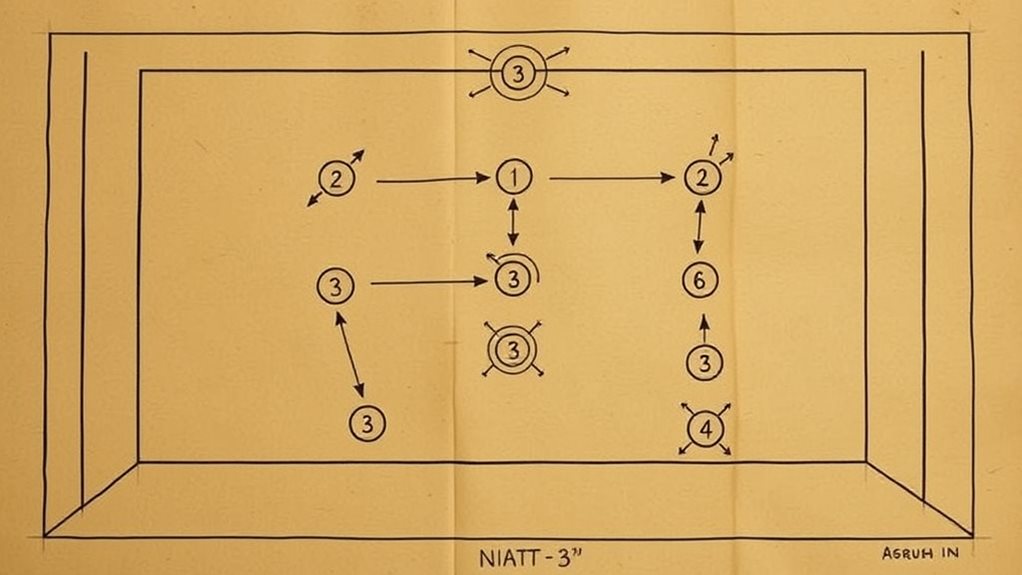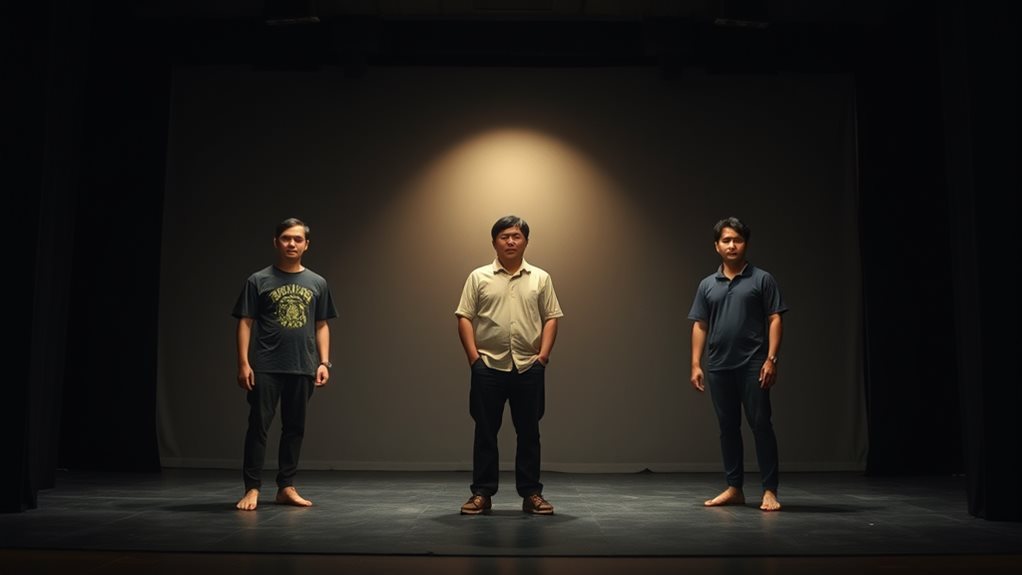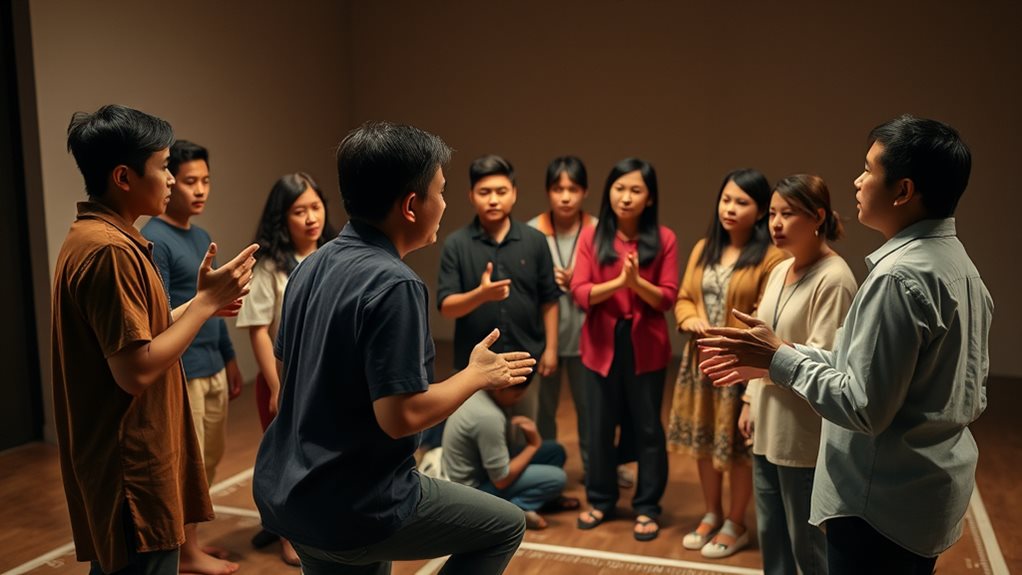Understanding Stage Positions****
In traditional Filipino stage blocking, performers use established stage positions like upstage (the area farthest from the audience) and downstage (the area closest to the audience) to convey meaning. These positions are crucial in telling the story through movement.
Blending Influences
Filipino stage blocking is a unique blend of indigenous and Western influences. To master this blend, performers must be precise in their movements, as they convey emotions and tension. Deflection and evasive maneuvers are essential skills to convey tension, and performers must practice these movements to achieve a natural flow.
Collaboration is Key
Consistency in blocking is vital, and performers must collaborate with their director and stage manager to achieve impactful performances. This collaboration ensures that the story is told effectively and that the audience is engaged.
Adding Visual Interest
To add visual interest to a performance, performers can use varying levels, such as stairs, platforms, or ramps, to create a dynamic stage presence. This variation adds depth and dimension to the performance, making it more engaging for the audience.
Mastering the Nuances
Filipino stage blocking is a rich and complex theatrical language that requires further exploration and practice to master. By understanding and applying these principles, performers can create powerful and engaging performances that showcase the unique blend of indigenous and Western influences.
Historical Influences

Philippine theatre's roots in indigenous performances significantly influenced its stage blocking**. In these performances, ritualistic movements** and storytelling dictated spatial arrangements. For example, the priest or priestess's movements during entranced states, the choreography of epic poetry recitations, or the dynamic interplay of verbal jousts showcased the importance of movement in storytelling.
These performances often unfolded within the natural environment, using the landscape itself as a backdrop.
Colonial adaptations dramatically altered stage blocking. The Spanish comedia introduced formalized staging and choreographed battles, as seen in the *kumedya* or *moro-moro* with its stylized combat and distinct character placements.
Zarzuelas further refined these conventions with more complex set designs and interactions. Movement became carefully planned, reflecting the narrative and character relationships.
American influence brought new theatrical paradigms. Broadway's influence introduced more westernized staging techniques.
However, the unique characteristics of *bodabil* showcased Filipino adaptability, with fast-paced changes and integration of diverse acts demanding fluid stage dynamics and swift transitions.
This blend of traditional Filipino movement and staging evolved, adapting and incorporating diverse influences into a uniquely Filipino theatrical language****. This is reflected in modern productions that use these diverse influences.
Western Staging Principles
Western Staging Principles
By the late 19th and early 20th centuries, Western theatrical traditions significantly impacted global stagecraft, including the Philippines.
Understanding Stage Types
Different stages require unique blocking strategies. Proscenium stages, where the audience sits on one side, demand consideration of sightlines and the fourth wall. In contrast, thrust stages, which extend into the audience, require accounting for audience members on three sides to ensure everyone has a good view.
Stage Type Comparison
| Stage Type | Advantages | Disadvantages |
|---|---|---|
| Proscenium Stage | Clear sightlines, traditional audience experience | Limited audience interaction, can feel distant |
| Thrust Stage | Intimacy, audience engagement | Sightline challenges, complex blocking |
| Theatre-in-the-Round | Immersive experience, unique audience perspective | Challenging scenery, difficult sightlines |
Blocking Decisions
Understanding these stage types informs your blocking decisions. You must consider not only the placement of actors but also the overall flow and pacing of the scene. The director's vision and the play's style influence how you utilize these principles. Effective staging enhances the storytelling and audience experience.
Key Stage Positions

Understanding key stage positions is crucial in traditional Filipino theater. These positions guide actor placement, movement, and interaction, ultimately affecting audience engagement. The terms "upstage" (rear of the stage) and "downstage" (front, nearest the audience) are essential, with movement from upstage to downstage naturally increasing audience engagement.
Stage left and stage right are from the actor's perspective. These terms are vital for directing movement and ensuring consistent placement. For instance, if an actor is instructed to move to stage left, they'll move to their left side. You may also come across "prompt" and "bastard/opposite prompt" as synonyms.
House left and house right reflect the audience's viewpoint. These terms mirror stage left and right, providing a crucial perspective for aligning the performance with what the audience sees, maximizing their experience.
Crossing the stage has a significant impact. To "cross" means moving across the stage, such as from upstage right to downstage left.
These crossings aren't random; they manage actor dynamics, ensuring smooth scene transitions and enhancing the dramatic flow. Careful planning of crossings prevents visual obstructions and maintains audience focus, increasing their engagement.
Essential Blocking Techniques
Effective Blocking Techniques Enhance Storytelling****
Traditional Filipino stage blocking relies on precise movements and carefully planned positions to engage the audience and advance the narrative. Blocking isn't just about standing in the right spot; it's about creating dynamic interactions and conveying emotion through movement****.
To master this technique, actors must understand how to use their bodies to tell the story.
Deflection Techniques Redirect Energy****
Deflection techniques are essential in blocking. These techniques involve skillfully redirecting an opponent's energy or actions, rather than directly confronting them.
For example, an actor might subtly shift their weight, create space, or use a slight turn to avoid a direct confrontation. This adds subtlety to the performance while staying true to the narrative.
Evasive Maneuvers Add Depth****
Evasive maneuvers are also crucial in blocking. These involve deftly avoiding a character's gaze, subtly stepping aside, or changing body language to suggest evasion.
This technique doesn't necessarily mean running away; instead, it adds depth to the performance and conveys tension or conflict.
Timing and Precision Are Key
Mastering blocking techniques requires practice and precision. A poorly executed block can disrupt the flow of the performance, while a well-timed one can heighten the dramatic effect****.
Actors must refine their technique, focusing on how these actions serve the narrative. By doing so, they can elevate their stage presence and create a truly immersive experience.
Collaborative Blocking Process

Collaborative Blocking Process
Actor-Director Collaboration
Effective blocking is a team effort between the actor, director, and stage manager. The director guides the blocking, instructing actors on movement and interaction, considering sightlines and lighting design.
Actors rehearse each scene individually before proceeding, and the director, stage manager, or assistant director records these movements to ensure consistency.
The Stage Manager's Role
The stage manager plays a crucial role in maintaining blocking consistency. They meticulously document actor positions and movements throughout rehearsal, ensuring actors follow established blocking in each performance.
The stage manager also coordinates with the director and crew for smooth implementation and communicates any blocking changes.
Understanding Stage Layout
To navigate the stage, actors must understand upstage, downstage, stage left, and stage right. These terms allow for precise directorial instructions.
Actors must consider the audience's perspective, including house left and house right, and the stage's configuration, such as whether it's raked, when making blocking choices.
Artistic and Cultural Context
The director balances artistic vision with practical considerations, influenced by the artistic and cultural context.
For example, minimalism might demand different blocking than naturalism. The director's vision and practical considerations shape the final blocking decisions.
Visual and Spatial Impact
Visual and Spatial Impact
Creating Visual Interest
Through careful manipulation of stage space, you create visual interest and enhance the storytelling. To achieve this, visualize the stage as a nine-square grid to precisely communicate actor positions, considering downstage, upstage, and stage/house left and right.
Crossing, or movement across the stage, is crucial for creating dynamic spatial relationships. Additionally, employ asymmetry**** to generate visual tension and focus the audience's attention.
Building Visual Interest
Vary actor levels, such as standing, sitting, or using platforms, to build visual interest and subtly communicate power dynamics or emotional depth. Strive for a balanced composition, ensuring smooth transitions between scenes.
Moreover, maintain audience visibility at all times.
Mastering Spatial Relationships
Mastering spatial relationships is key to effective storytelling. You utilize space to symbolize relationships, conflicts, and narrative shifts.
Natural movements, guided by character development and narrative arc, enrich the performance. Think creatively; break from standard configurations to reflect thematic elements and heighten emotional depth within scenes.
Blocking and Collaboration
Blocking isn't just about placement; it's about building visual tension and shaping the emotional journey. Your blocking must complement lighting design and camera movement (in film productions), ensuring clear sight lines for the audience.
The stage manager documents your positions for consistency during subsequent performances, while the director's guidance ensures the intended dramatic impact.
Questions and Answers
How Do I Memorize My Blocking?
Memorizing blocking requires a combination of visualization, rehearsal, and note-taking.
To start, visualize the stage by imagining the set, props, and other elements that will be present during the performance. This will help you associate specific movements with specific locations.
Practice consistently by rehearsing your blocking regularly, using the same movements and gestures each time. This repetition will help solidify the movements in your memory.
Utilize notes by writing down specific details about your blocking, such as the number of steps it takes to get from one point to another or any specific gestures or movements. Reviewing these notes regularly will help reinforce your memory.
What if I Forget My Blocking?
If you forget your blocking, refer to your rehearsal notes and stage cues for guidance.
When you forget your blocking, it's essential to stay calm and rely on your preparation. Quickly glance at your rehearsal notes to refresh your memory. Additionally, use stage cues such as props, set pieces, or other actors' movements to help you get back on track. If needed, improvise subtly to recover from the mistake, but avoid drawing attention to the error. After the performance, review your blocking rehearsal to identify areas for improvement and refine your skills for future productions.
Can I Improvise My Movements?
You can improvise your movements to some extent. While scripted blocking is crucial, you have some freedom to adjust your movements during a performance. However, improvisation techniques are only allowed during carefully planned rehearsals, not during actual performances. This ensures that the overall flow and choreography of the production are maintained.
How Do I Handle Blocking Changes?
Mastering blocking changes requires precise techniques and spatial awareness.
To achieve this, communicate clearly with your partner to ensure you're both on the same page. This involves verbal cues such as calling out directions or warning your partner of an incoming attack. Practice diligently to develop muscle memory and fine-tune your movements. This includes repeated drills to perfect your footwork, positioning, and reaction time. Refine your movements by focusing on seamless transitions between blocks. This can be achieved by keeping your center of gravity low and using your opponent's momentum against them.
What Props Affect My Blocking?
Prop placement affects your blocking in three significant ways.
Firstly, it influences movement dynamics. For instance, if a character needs to move across the stage, a prop like a large piece of furniture can obstruct their path, altering their movement.
Secondly, prop placement impacts character interaction. For example, if two characters are having a conversation, the placement of a prop like a coffee table between them can influence their body language and dialogue delivery.
Lastly, prop placement affects scene transitions. A well-placed prop can help signal the start or end of a scene, such as a character turning off a lamp to indicate the end of a scene.